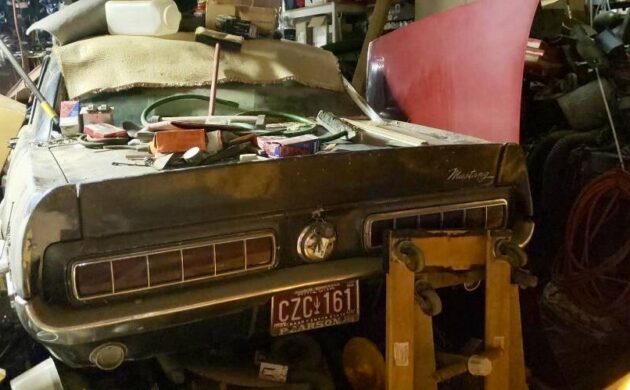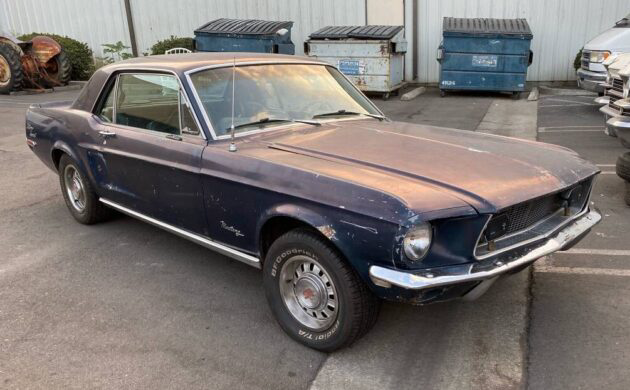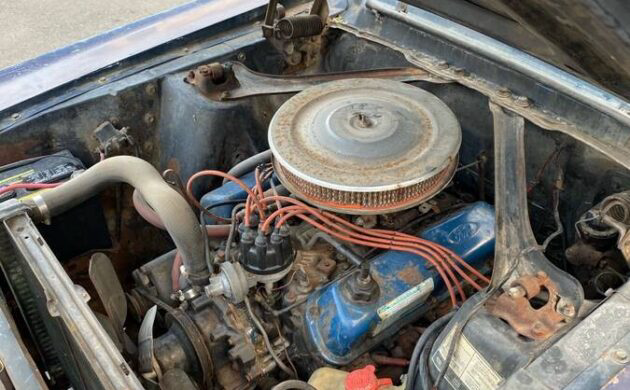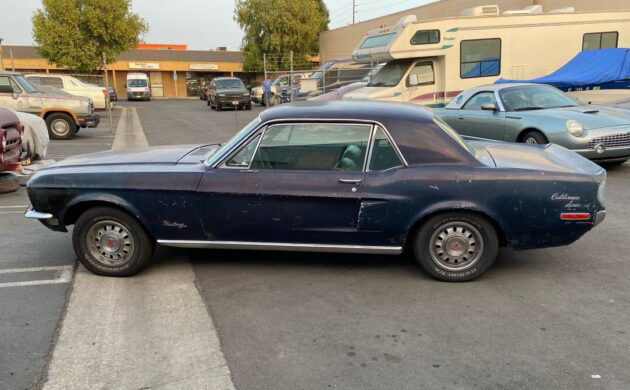Vehicle manufacturers love special edition vehicles, especially if they can produce those cars using existing components from their parts bin. Ford was no stranger to that practice and employed it in the ultra-successful First Generation Mustang to boost already impressive sales figures. It released some variants on a regional basis, including the 1968 Mustang California Special. Our feature car is 1-of-4,118 produced and has sat in this garage for thirty-five years. It is a solid and complete classic but requires total restoration. If you feel up for the challenge, it is listed here on Craigslist in La Habra, California. It could be yours for $14,000, and I must thank Barn Finder MattR for spotting this promising project.
It is unsurprising to find many familiar additional cosmetic enhancements gracing the exterior of a California Special because the company received significant design input from the great Carroll Shelby. These include the non-functional side scoops, the distinctive taillights, and the Shelby rear spoiler. Ford added a couple of badges, a grille sans badging, and a set of Lucas foglights. All those items remain intact on this Presidential Blue classic, although the attached Marti Report confirms the wheels are a later addition. The Mustang split its life between California and Arizona before being parked by its owner in 1987. The paint looks tired, but spending life in dry climates has preserved its original steel. The buyer won’t face rust repairs, only needing to address the minor bruises and bumps in the panels. The foglights look correct, and I think they remain mounted on the correct stand-offs. The bumpers sport damage that may prove irreparable, but the remaining trim and tinted glass look fine.
It’s pretty easy to sum up this Mustang’s interior condition; It’s complete but requires total restoration. First Generation Mustangs are attractive as project cars because high-quality restoration parts are readily available and affordable. Returning this one to its former glory should cost around $2,200, but it would be a wise investment to maximize this classic’s value and visual appeal. The only visible aftermarket addition is a stereo occupying the spot usually reserved for the original AM radio. The first owner selected a console and deluxe seatbelts when ordering the vehicle but turned their back on comfort features such as air conditioning.
It is unclear whether this California Special is numbers-matching, but the Marti Report indicates the original owner ordered this classic powered by the 195hp C-Code 289ci V8 while also selecting a three-speed C4 automatic transmission and power steering. That last feature is interesting because I see no evidence of the power steering pump or hoses in the engine bay photo. Is it possible that we’ve discovered a mistake in a Marti? Only further investigation will reveal the truth. This Mustang’s engine and transmission package is the most sedate in the V8 range, allowing the car to take 16.7 seconds to cover the ¼ mile. However, if the buyer isn’t fixated on originality, extracting additional ponies to improve performance is neither difficult nor expensive. The V8 doesn’t run and probably hasn’t since 1987. It does turn freely, opening the possibility of revival without spending a fortune.
With 317,404 Mustangs finding homes in 1968, we could not classify that year as a sales disaster. However, after the dizzying total of 1966, it marked a drop of nearly 50% in two years. Ford planned to build 5,000 examples of the California Special to boost 1968 Mustang sales, but the demand wasn’t what it expected. The California Special and the rarer High Country Special didn’t contribute enormously to the total, but that wasn’t a financial concern because they cost the company peanuts to develop. If buyers in the current market desire either of these special editions, they can expect to pay slightly more for the High Country Special due to its low production numbers. However, restored to a high standard, this CS could command a value beyond $38,000. Its lack of rust and the presence of the unique components comprising the package means it should be a straightforward project. Are those thoughts enough to make you consider making it part of your life?












Owning A 1967 mustang in the past and how those power steering sleeves leaked like titanic with the hoses too.. I wouldn’t be surprised if it wasn’t bypassed and taken off with a cheap manual conversion.
I rebuilt mine with reproduction parts and in kess than a year the sleeves started again and then i went to manual conversion
Good luck with sale !
It will hopefully go back to original specs !
Classic Steel,
After having similar leak problems after rebuilding, we sent our hydraulic cylinders to a special shop that didn’t just rebuild then with new seals, they took the long pistons and re-plated them with industrial chrome plating [copper plating underneath] until back to original specs. We started doing this with all the P/S systems with a piston/cylinder, including Rolls-Royce Silver Cloud, Packards and Studebakers. No more leaks, and they guaranteed them against leaks for 5 years.
You are correct.. When we got one of these in the shop, we would micrometer the shaft and other wear areas and then decide to reseal or re-plate the shaft. To just throw new seals on a worn out unit made no sense and as the saying goes, “there’s never enough money to do the job right the first time, but plenty of money to do it over the second time”.. Go figure.
Piper,
“there’s never enough money to do the job right the first time, but plenty of money to do it over the second time”..
I love that quote. Back in the 1980s I had a local sign painter make up some small signs with that quote, and I put them up around my restoration shop’s work areas and the offices.
I also had another sign in my main shop area for all my techs to see:
“Do the job correctly, and get paid for the work. Do it again to fix your mistake, and WE don’t get paid the second time”.
My customers loved both signs, and new visitors almost always made reference to the signs.
Looked at one in 1981 to buy $2500 with an original S code 390 and a 4spd ah to have that chance again
I owned the only white with blue stripes one. I bought it from the original owner back in the mid 90’s. I hate the 68-69 GT wheels so I got a set of Sheby 10 spokes for it. It completed the look. I kid of wish I still had that car.
Absolutely a great find!
The writer of this article is way off in an estimate of $2200 “to bring this CS back to its former glory”. More realistically between $12-$15k especially if someone is going to paint it, fully rebuild the brakes and suspension, freshen the interior. Plus who knows the status of the engine; it appears to not have its original 289 judging from the photos, it looks like a mid to late 70’s 302.
For someone with money, skills and time this would be an excellent project.
$2200 was referencing replacing the interior with a new trim kit. Definitely a lot more for the overall restoration. A nice find though and I think the price is pretty good.
I agree, no P/S pump either??
EMC66 How can you tell it’s a mid to late 70’s 302. ??? I thought the only way to tell a 289 from a 302 was to check the stroke or the numbers on the crank and rods, just wanting to learn here – no disrespect intended .
So it does not run now? Older photos used?
I have a question for the BarnFind brains: My son owns a ’68 Mustang coupe with a 289, auto trans and an apparently fairly rare bench seat. Would this make it any more valuable (or possibly less) than the same model with standard bucket seats?
Thanks for any input, as my son is considering whether to invest in restoration.
Dan Williams,
Having appraised cars for over 40 years, including several Mustangs with Bench seats [even a 1968 Non-GT fastback with 6 cylinder and Pony bench seat], I can try to give you an answer to your question.
The vast majority of people who want to buy a 1968 Mustang will be more interested in a bucket seat interior. Those people will probably not want to spend additional money for a bench seat car.
There are more than a few Mustang collectors in north America who are always interested in unusual and unique Mustangs, and for these people, yes, your Mustang might be worth a little bit more. If it’s a beautiful example it could be worth between 5% and 10% more of the total value. If it’s the very unusual Pony variant bench seat, that percentage could possibly double.
Invest in the restoration not because it’s a bench seat car, but because you like the car. When it involves restoring a Ford product that has rare option codes, I always stress the need for a Marti report to ensure the car did come with those special options when new.
Invest is the key word. Is it going to need a full blown “shop” resto and the big dollars to do it right ? Only a few of them are going to maintain value in the future. If it’s a driver he already has and just needs a bit more to doll it up and drive because he likes the car, enjoy. It’s not a particularly valuable model in general. Have fun with it.
This would be a great investment if you want to restore it.. Money back guaranteed.. Add in shipping, higher cost of parts and paint etc., the return on investment may take a few years.. Most importantly, inspect the engine and transmission for numbers matching.. These are nice cars and still in demand. Great find and great car..
Someone above noticed the lack of a power steering pump. My restoration shop added power steering and brakes to numerous Mustangs over the years, It’s not an overly difficult job. It involves adding the P/S parts to the steering system and the pump assembly to the engine.
If Marti says it came with P/S from the factory, it probably did. I notice it’s got a 2-groove pulley on the Alternator, and if my memory is correct, that’s a sign it had P/S at one time [or the replacement alternator was from a car with P/S]. I would check the crank pulley to see if it has a single or dual groove. If it’s dual groove, it likely had P/S. And it’s possible the pump failed and was removed, so check the steering system underneath to see if the slave cylinder is still there. It could be a case of simply replacing the pump and bracket.
It’s possible the P/S was removed at the dealer when new, if the buyer didn’t want the option. It’s also likely that the dealer would not change the crank pulley or the Steering box. If I remember, the manual box was 19:1, and the P/S box was 16:1. So it’s possible to determine what box is there. If P/S is added by a new owner and the car has a manual box, you really should change it to a P/S box, as it can be overly sensitive.